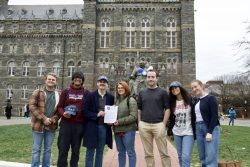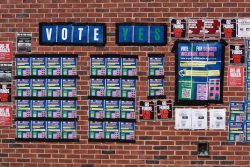A proposed protest zone on the National Mall threatens to sanitize demonstrations and curtail freedom of assembly—all to protect some worn-down grass.
The protest zone, which would fill in the Capitol reflecting pool next to the Grant Memorial, is part of the National Park Service’s National Mall Plan, a redesign program meant to preserve the Mall from the stress of visitors and events while still keeping it open to demonstrations and other gatherings.
The Park Service’s plan for the area includes restrooms, seating and a media stand, according to the Washington Post. The plan, which is still open to public comment, will be constructed using ideas from three different designs.
Unfortunately, the protest zone plan stresses preservation over protests and, ultimately, free assembly. By creating a designated free speech zone, the National Park Service would imply that other areas of the Mall are not free speech friendly and make protesters there more vulnerable to punitive action.
Mall demonstrations are important to both national politics and campus life. Previous anti-war protests and this week’s March for Life both included Georgetown students.
The National Park Service does a good job protecting and preserving national monuments and parks, but it shouldn’t be allowed to infringe on civil liberties.
Demonstrations are meant to be seen, to show opponents and the uninvolved that people care about an issue. If protests on the Mall are confined to Union Square, they won’t be able to reach people who are not already interested enough in an issue to attend a demonstration. Moreover, they’ll be limited in tactics and size, weakening their appeal to media outlets. Preaching to a choir standing in government-constructed bleachers and with great restroom access is almost as ineffective as not protesting at all.
Conservation of the National Mall is important, and becomes more difficult every year as it hosts more events and visitors. “Facilities can be overwhelmed with use, and vegetation cannot easily recover when turf becomes worn to the ground,” according to the planning report. Still, it’s better that grass be replaced and sidewalks repaved than political liberties suffer permanent erosion.




